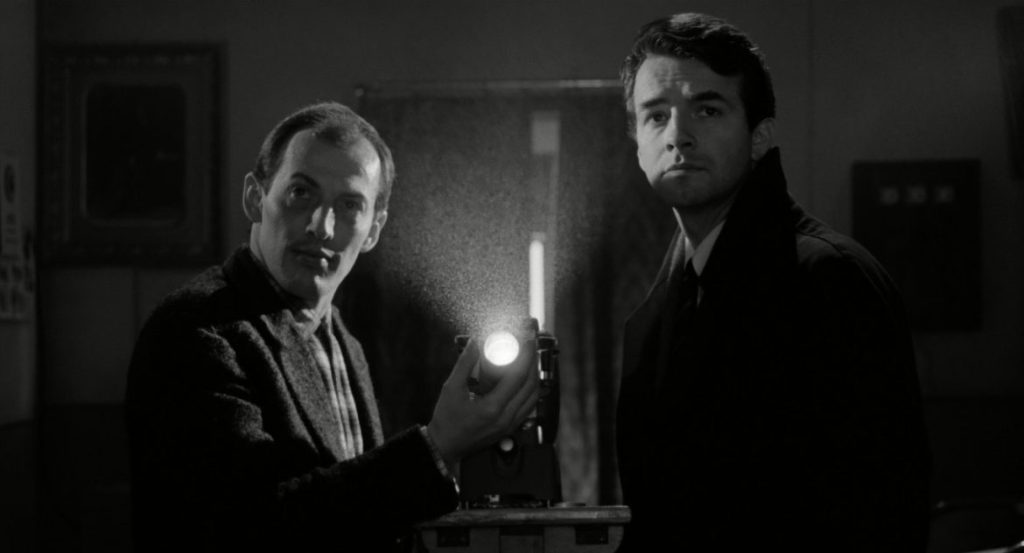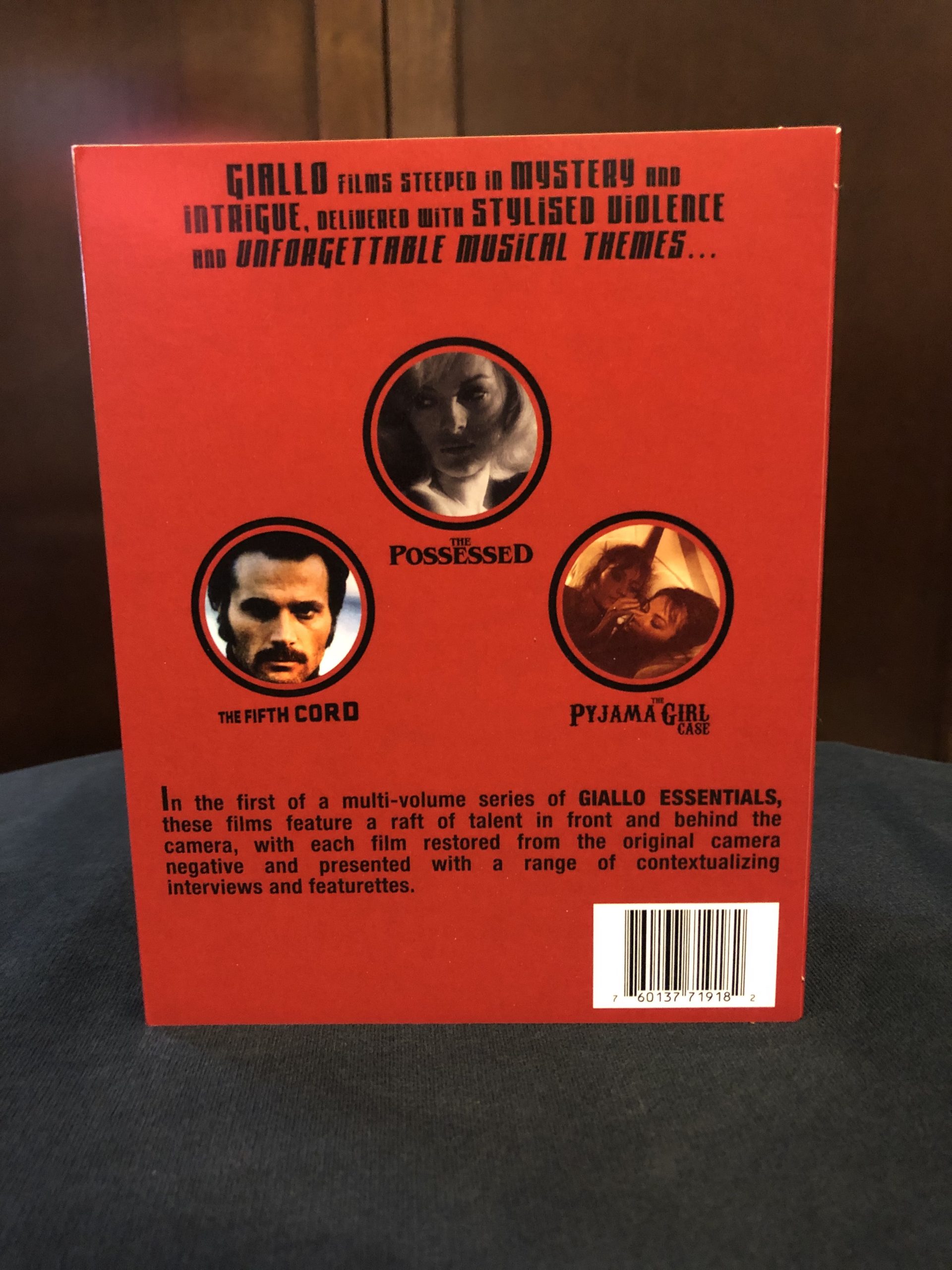Alongside the spaghetti western, the giallo is one of the most famous Italian export genres: films steeped in mystery and intrigue, delivered with stylised violence and unforgettable musical themes. The Possessed (1965) masterfully combines noir, mystery and giallo tropes in a proto-giallo based on one of Italy’s most notorious crimes. It tells the story of a depressed novelist (Peter Baldwin) in search of his old flame (Virna Lisi) who has disappeared under suspicious circumstances, prompting an investigation that finds him plunged into a disturbing drama of familial secrets, perversion, madness and murder. The Fifth Cord (1971) boasts a complex, Agatha Christie-esque plot of investigation into a series of brutal assaults. As the body count rises, whisky swilling journalist Andrea Bild (Franco Nero) finds himself under suspicion, making it all the more imperative he crack the case. The Pyjama Girl Case (1978), inspired by a real-life case that baffles to this day, takes us to Australia where former inspector Timpson comes out of retirement to crack the case of a young woman, found on the beach, shot in the head, burned to hide her identity and dressed in distinctive yellow pyjamas… In the first of a multi-volume series of Giallo Essentials these films feature a raft of talent in front and behind the camera with each film restored from the original camera negatives and presented with a range of contextualising interviews and featurettes.

The Possessed (1965)
The Possessed is a wonderfully atmospheric proto-giallo based on one of Italy’s most notorious crimes, The Alleghe killings, and adapted from the book on that case by acclaimed literary figure Giovanni Comisso. Peter Baldwin (The Ghost, The Weekend Murders) stars as Bernard, a depressed novelist who sets off in search of his old flame Tilde (Virna Lisi, La Reine Margot), a beautiful maid who works at a remote lakeside hotel. Bernard is warmly greeted by the hotel owner Enrico (Salvo Randone, Fellini’s Satyricon) and his daughter Irma (Valentina Cortese, Thieves Highway, The Iguana with the Tongue of Fire), but Tilde has disappeared under suspicious circumstances. Bernard undertakes an investigation and is soon plunged into a disturbing drama of familial secrets, perversion, madness and murder… Co-written by Giulio Questi (Death Laid an Egg, Arcana) and co-directed by Luigi Bazzoni (The Fifth Cord, Footprints on the Moon), The Possessed masterfully combines film noir, mystery and giallo tropes, whilst also drawing on the formal innovations of 1960s art cinema (particularly the films of Michelangelo Antonioni.) A uniquely dreamlike take on true crime, The Possessed is presented here in a stunning new restoration.
The Possessed would make for an interesting entry point into the giallo subgenre if simply for the fact that it stands so clearly apart from what most people think of when they imagine the genre. Perhaps most obvious would be that the film is shot in beautiful black-and-white with a keen sense of how to maximize the uncomfortable nature of negative space. The other aspect that may seem at odds with the genre is how few bodies end up as victims at the end of the day. The film is more cerebral than most, and it loves to play up the more dreamy aspects that Bernard may or may not be experiencing in his “peaceful” lakeside getaway. The film derives a lot of fun from the fact that the audience is never quite on firm footing with the facts and they are left to draw their own conclusions much of the time. This might be especially surprising since this is supposedly inspired by some real life murders called the Alleghe Killings which should make things less opaque. Yet, this is not what interests the co-directors of the film, who are more keen on creating an art film rather than anything that conforms to genre conventions. The result is something quite magical and transfixing as the performers skillfully bring pathos to this mysterious story.

The Fifth Cord (1971)
The success of Dario Argento’s The Bird with the Crystal Plumage ushered in a host of imitators, seeking to capitalize on this new, modern take on the giallo thriller. Many were highly derivative, but a number nonetheless rose above the crowd thanks to skillful execution and a willingness to experiment stylistically. One such example is The Fifth Cord – which, in the hands of director Luigi Bazzoni (The Possessed, Footprints on the Moon), turns a conventional premise into a visually stunning exploration of alienation and isolation. When a man barely survives a brutal assault en route home from a New Year’s party, washed-up, whisky-swilling journalist Andrea Bild (Franco Nero, Django) is assigned to report on the case. Before long, the maniac strikes again, this time with fatal results. As the body count rises, Andrea falls under suspicion himself, making it even more imperative that he crack the case. His only clue lies in a series of black gloves found at the location of every attack, each with a finger cut off… Adapted from a novel by David McDonald Devine, The Fifth Cord boasts a complex, Agatha Christie-esque plot, outstanding cinematography courtesy of future Oscar-winner Vittorio Storaro (Apocalypse Now) and supporting appearances by a raft of genre stalwarts, including Silvia Monti (A Lizard in a Woman’s Skin), Edmund Purdom (Nightmare City) and Rossella Falk (Sleepless). Debuting here in high definition, arguably the most visually stunning giallo ever made now shines like never before.
When you want to let the audience know you are in good hands, you bring in Franco Nero to lend his gravitas to the proceedings. In what is a bit of a recurring theme with this set, The Fifth Cord is not like typical giallo films, but it definitely fits within the genre and rises to the ranks of one of the best not to originate from one of the expected masters. While admittedly the plot can get a bit knotty and overstuffed for the average audience member, the tightly-paced narrative never fails to deliver something truly engaging. While the narrative twists and turns may be in large part responsible for this, there is no denying that the photographic prowess of cinematographer Vittorio Storaro brings a level of elegance to this picture that does not allow you to look away. The composition of each scene gives the film an added layer of texture that not only dazzles the eyes but speaks to a larger truth about the subjects within the frame. While the subject is typically Nero commanding the screen, special attention should also be paid to Silvia Monti as the alluring Helene. The identity of the killer may not be completely satisfying, but he path to that point is one that is so engaging.

The Pyjama Girl Case (1978)
Throughout the late 1960s and into the 70s, the Italian giallo movement transported viewers to the far corners of the globe, from swinging San Francisco to the Soviet-occupied Prague. Only one, however, brought the genre’s unique brand of bloody mayhem as far as Australia: director Flavio Mogherini (Delitto passionale)’s tragic and poetic The Pyjama Girl Case. The body of a young woman is found on the beach, shot in the head, burned to hide her identity and dressed in distinctive yellow pyjamas. With the Sydney police stumped, former Inspector Timpson (Ray Milland, Dial M for Murder) comes out of retirement to crack the case. Treading where the “real” detectives can’t, Timpson doggedly pieces together the sad story of Dutch immigrant Glenda Blythe (Dalila Di Lazzaro, Phenomena) and the unhappy chain of events which led to her grisly demise. Inspired by the real-life case which baffled the Australian police and continues to spark controversy and unanswered questions to this day, The Pyjama Girl Case is a uniquely haunting latter-day giallo from the tail end of the genre’s boom period, co-starring Michele Placido (director of Romanzo Criminale) and Howard Ross (The New York Ripper), and featuring a memorably melancholic score by veteran composer Riz Ortolani (Don’t Torture a Duckling).
The Pyjama Girl Case is the film in this set that is perhaps the most challenging to enjoy on a single viewing simply due to the disorienting nature of the structure. Sure, if you read the description above it lays things out pretty clearly, but those who like to go into a story blind may wonder exactly why we are following certain inconsequential stories until things start slowly clicking into place in a really satisfying manner. While you certainly can enjoy the film the first time you watch it, there is much to enjoy on repeat viewings as you see the connective tissue of the tragic events that transpire. The performances are fine all around, but it is most intriguing seeing veteran actor Ray Milland show that he still had gas in the tank as an old-school detective who shirked away from technology and held on to his strong sense of how investigations should be conducted if you want to achieve results. There is not the constant threat of violence that plagues most giallo films, but when the brutality does show up it hurts a bit more due to how the film demands your emotional investment through character building. Even in retrospect, the film is a bit messy in parts but it is one that you should not overlook.

Video Quality
The three films in the Giallo Essentials: Volume One (Red Edition) box set are packaged together on Blu-Ray after being released separately by Arrow Video with 1080p masters in their original aspect ratios. Each of these films have been restored from their original camera negatives with a 2K scan. By and large these three releases are very similar to one another and will be discussed as a group with any meaningful differences pointed out.
The only word to describe these presentations is beautiful. The striking photography which captures the sumptuous locations sparkles in high definition with natural grain intact and nicely resolved. There is a fantastic amount of detail present with nice textures on the clothing, both in the fancy clothing of some of the antagonists to the shabby street clothing of some of the protagonists. The new transfer shows off a great amount of depth and enhanced detail, but admittedly the close-up shots hold up better than the long shots. There are certain elements like close-up shots of flowers or charred bodies that look quite striking in their clarity. Black levels are very deep with no trace of black crush or compression artifacts. The contrast is well defined, and there is virtually no print damage to be found outside a few stray moments. Arrow Video has done a miraculous job with all of these transfers in a way that should make anyone who decides to pick this set up extremely happy.
Audio Quality
The Pyjama Girl Case comes with a DTS-HD 1.0 Master Audio mono track in Italian and English, while The Possessed and The Fifth Cord are given LPCM 1.0 mono tracks in Italian and English language options. Every single one of these tracks represents these worlds in a pretty impressive way sonically. Most of these films have their dialogue post-looped which results in some loose sync instances that may be annoying to some, but it is a product of this period in filmmaking. Many of these tales take place in a bustling city which creates a din of sound that creeps through to provide some excellent ambient details. The Possessed, on the other hand, conveys its sense of isolation well with crisp, subtle environmental texture. All of the various sounds in the mix seem accurately rendered so that nothing ever feels off. The dialogue itself comes through crystal clear without being crushed by the sound effects or score. There are moments of fighting that pack a punch without becoming a muddled mess in the action. The memorable, atypical music throughout these films brings a very distinct mood to the proceedings that is represented well in the mix. Everything is presented with an excellent fidelity with only the occasional instance of sound presenting as a bit thin or boxy. This presentation is free of any hiss or other age-related wear-and-tear. Another 5-star effort from Arrow Video.

Special Features
The Possessed
- Audio Commentary: Film Historian Tim Lucas delivers a thoroughly entertaining commentary track in which he discusses the film’s history, the creative output of the creative figures, the plot and themes of the film and more that adds a lot of great context to this film.
- Richard Dyer on The Possessed: A 25-minute video essay from cultural critic Richard Dyer in which he discusses its place in the giallo genre, the structure of the film, the real-life case and the novel that inspired the feature, the talent behind the scenes, the artistry of the picture and more.
- Lipstick Marks: A 12-minute interview with makeup artist Giannetto De Rossi in which he discusses his intimidating presence on set, disagreements he had with performers, scenes of which he is most proud, the care he takes with his work and more. This man is a real character and probably has even more wild stories to share.
- Youth Memories: A 16-minute interview with assistant art director Dante Ferretti in which he discusses getting into the film business, some of his most notable projects, the scenes that stick out most in his memory and more tidbits about his career.
- The Legacy of the Bazzoni Brothers: A 31-minute interview with Francesco Barilli, a friend of both co-director Luigi Bazzoni, as well as Luigi’s brother Camillo. Barilli provides a lot of incredible information about the brothers and their place in the film business.
- Original Trailers: This disc provides the Italian Trailer (2:12) and English Trailer (2:12).
The Fifth Cord
- Audio Commentary: Film Journalist Travis Crawford provides a really thoughtful commentary track in which he discusses how the film differs from others in the genre, the cinematography of the feature, the talents of Franco Nero, the locations in the film and more that provides details you may overlook on a single viewing.
- Lines and Shadows: An 18-minute video essay from film critic Rachael Nisbet in which she delves into the unique cinematography and production design of the film. In this piece there are discussions about how the script tackles modernity and class dynamics in the 20th century in a way most films in the genre do not, how architecture reflects the emotions of the characters, the unique framing of certain shots and much more that is very intriguing.
- Whisky Giallore: A 28-minute piece in which film critic Michael Mackenzie offers his take on the film and why it deserves a greater appreciation within the genre, the way in which it tackles the normal tropes and subverts others, the performances in the film, the thematic twists and turns and more.
- Black Day For Nero: A 24-minute interview with actor Franco Nero in which he reflects back upon his time with the thriller, his collaborations with his friends, the need to not have his character be a perfect hero, his continued collaborations with the filmmakers and more.
- The Rhythm Section: A nearly 22-minute interview with editor Eugenio Alabiso in which he discusses the Italian film industry in the 70s, his memories of the cast and crew, his love of the screenplay, the times he had to fight to get money that was owed to him, anecdotes about some of his other work and more.
- Deleted Sequence: A two-and-a-half minute deleted montage is included here that was found with the original film elements. It does not really add anything to the film, but it’s a unique discovery for fans of the film.
- Trailers: This disc provides the Italian Trailer (3:03) and English Trailer (3:03).
- Image Gallery: A collection of images showing off promotional materials, stills and more.

The Pyjama Girl Case
- Audio Commentary: Film Critic Troy Howarth delivers a great and fact-filled commentary track in which he discusses the unique history of some of singer Amanda Lear, the unconventional nature of the feature, where the giallo genre was at the time the film was released, the structure of the film, the performers utilized in this story and more that makes for a good listen.
- Small World: A nearly 29-minute interview with film critic Michael Mackenzie in which he discusses the internationalism of the film industry and how it impacted giallo films specifically. There are talks of how it impacts narrative, the use of post-dubbing, the lack of appreciation for the film and more.
- A Good Bad Guy: A 32-minute interview with actor Howard Ross in which he discusses getting involved with the production, his appreciation of the director, his memories of his fellow performers, nude body doubles, the cinematography of the film, his preparations for certain key scenes and more.
- A Study In Elegance: A 23-minute interview with editor Alberto Tagliavia in which he discusses his friendship with director Flavio Mogherini, the elegance he brought to the proceedings, the process of editing the film without final music and more.
- Inside The Yellow Pyjama: A 15-minute interview with assistant director Ferruccio Castronuovo in which he recalls his memories of the film, the talented crew he befriended on this film, further collaborations with the film’s producer and more.
- The Yellow Rhythm: A 21-minute interview with composer Riz Ortolani in which he recalls his musical family, movies he regrets passing on, working with Americans, creating the sound of the film and more.
- Image Gallery: A collection of stills, behind-the-scenes photos and promotional material.
- Italian Theatrical Trailer: The four-minute trailer is provided here.
Final Thoughts
The three films in the Giallo Essentials: Volume One set represent a unique array of films from the genre that stand out for their quality but have often been overlooked in favor of films with more famous talent attached. These features push the boundaries of what we know about the artform while still providing the basics to allow fans a comforting familiarity. There is so much to appreciate about these works from the incredible talent on screen to the creatives behind the camera and among the crew that work together so well. Arrow Video has provided a set with a stunning A/V presentation and so many supplemental features that will keep you busy. If you have these films separately, there is no real reason to purchase this set besides the beautiful packaging (pictures below), but those who do not own these will find each of these films to be a gem waiting to be discovered and worthy of being a part of any collection. Highly Recommended
Giallo Essentials: Volume One (Red Edition) is currently available to purchase on Blu-Ray.
Note: Images presented in this review are not reflective of the image quality of the Blu-Ray.
Disclaimer: Arrow Video has supplied a copy of this disc free of charge for review purposes. All opinions in this review are the honest reactions of the author.











Dillon is most comfortable sitting around in a theatre all day watching both big budget and independent movies.







